An atlas for Schistosoma mansoni organs and life-cycle stages using cell type-specific markers and confocal microscopy
- PMID: 21408085
- PMCID: PMC3050934
- DOI: 10.1371/journal.pntd.0001009
An atlas for Schistosoma mansoni organs and life-cycle stages using cell type-specific markers and confocal microscopy
Abstract
Schistosomiasis (bilharzia) is a tropical disease caused by trematode parasites (Schistosoma) that affects hundreds of millions of people in the developing world. Currently only a single drug (praziquantel) is available to treat this disease, highlighting the importance of developing new techniques to study Schistosoma. While molecular advances, including RNA interference and the availability of complete genome sequences for two Schistosoma species, will help to revolutionize studies of these animals, an array of tools for visualizing the consequences of experimental perturbations on tissue integrity and development needs to be made widely available. To this end, we screened a battery of commercially available stains, antibodies and fluorescently labeled lectins, many of which have not been described previously for analyzing schistosomes, for their ability to label various cell and tissue types in the cercarial stage of S. mansoni. This analysis uncovered more than 20 new markers that label most cercarial tissues, including the tegument, the musculature, the protonephridia, the secretory system and the nervous system. Using these markers we present a high-resolution visual depiction of cercarial anatomy. Examining the effectiveness of a subset of these markers in S. mansoni adults and miracidia, we demonstrate the value of these tools for labeling tissues in a variety of life-cycle stages. The methodologies described here will facilitate functional analyses aimed at understanding fundamental biological processes in these parasites.
Conflict of interest statement
The authors have declared that no competing interests exist.
Figures
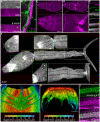
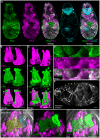

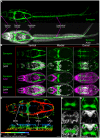


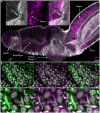
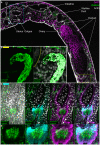

Similar articles
-
Labeling of the Schistosoma mansoni Tegument.Methods Mol Biol. 2020;2151:65-74. doi: 10.1007/978-1-0716-0635-3_6. Methods Mol Biol. 2020. PMID: 32451996
-
Cercarial transformation and in vitro cultivation of Schistosoma mansoni schistosomules.J Vis Exp. 2011 Aug 16;(54):3191. doi: 10.3791/3191. J Vis Exp. 2011. PMID: 21876520 Free PMC article.
-
Whole-organ isolation approach as a basis for tissue-specific analyses in Schistosoma mansoni.PLoS Negl Trop Dis. 2013 Jul 25;7(7):e2336. doi: 10.1371/journal.pntd.0002336. Print 2013. PLoS Negl Trop Dis. 2013. PMID: 23936567 Free PMC article.
-
A summary of the efficacy of praziquantel against schistosomes in animal experiments and notes on its mode of action.Arzneimittelforschung. 1981;31(3a):538-41. Arzneimittelforschung. 1981. PMID: 7016122 Review.
-
Gene suppression in schistosomes using RNAi.Methods Mol Biol. 2015;1201:143-64. doi: 10.1007/978-1-4939-1438-8_8. Methods Mol Biol. 2015. PMID: 25388112 Review.
Cited by
-
Functional genomic characterization of neoblast-like stem cells in larval Schistosoma mansoni.Elife. 2013 Jul 30;2:e00768. doi: 10.7554/eLife.00768. Elife. 2013. PMID: 23908765 Free PMC article.
-
Characterization of glutamate carboxypeptidase 2 orthologs in trematodes.Parasit Vectors. 2022 Dec 20;15(1):480. doi: 10.1186/s13071-022-05556-5. Parasit Vectors. 2022. PMID: 36539882 Free PMC article.
-
Molecular markers to characterize the hermaphroditic reproductive system of the planarian Schmidtea mediterranea.BMC Dev Biol. 2011 Nov 10;11:69. doi: 10.1186/1471-213X-11-69. BMC Dev Biol. 2011. PMID: 22074376 Free PMC article.
-
Secretory glands in cercaria of the neuropathogenic schistosome Trichobilharzia regenti - ultrastructural characterization, 3-D modelling, volume and pH estimations.Parasit Vectors. 2011 Aug 19;4:162. doi: 10.1186/1756-3305-4-162. Parasit Vectors. 2011. PMID: 21854564 Free PMC article.
-
The schistosome oesophageal gland: initiator of blood processing.PLoS Negl Trop Dis. 2013 Jul 25;7(7):e2337. doi: 10.1371/journal.pntd.0002337. Print 2013. PLoS Negl Trop Dis. 2013. PMID: 23936568 Free PMC article.
References
-
- Basch PF. New York: Oxford University Press; 1991. Schistosomes: Development, Reproduction, and Host Relations.248
-
- Skelly PJ, Da'dara A, Harn DA. Suppression of cathepsin B expression in Schistosoma mansoni by RNA interference. Int J Parasitol. 2003;33:363–369. - PubMed
Publication types
MeSH terms
Grants and funding
LinkOut - more resources
Full Text Sources

